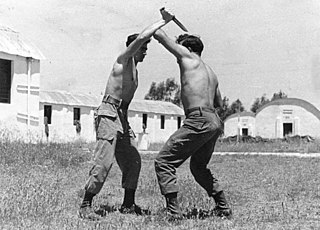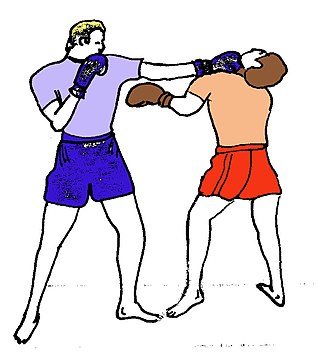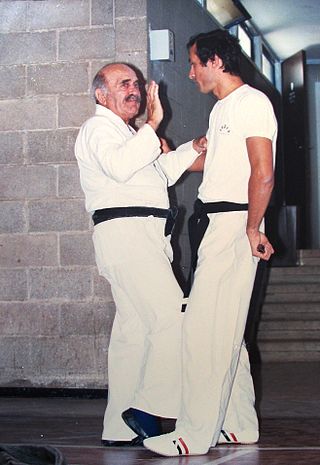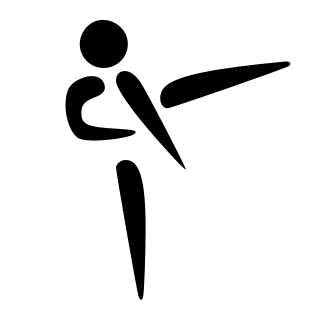Related Research Articles

Boxing is a combat sport and martial art. Taking place in a boxing ring, it involves two people – usually wearing protective equipment, such as protective gloves, hand wraps, and mouthguards – throwing punches at each other for a predetermined amount of time.

Kickboxing is a full-contact hybrid martial art and boxing type based on punching and kicking. Kickboxing originated in the 1950s to 1970s. The fight takes place in a boxing ring, normally with boxing gloves, mouth guards, shorts, and bare feet to favor the use of kicks. Kickboxing is practiced for self-defense, general fitness, or for competition. Some styles of kickboxing include: full contact karate, Muay Thai, Japanese kickboxing, Lethwei, Sanda, and Savate.

Krav Maga is an Israeli self defence system. Developed for the Israel Defense Forces (IDF), it uses techniques derived from Aikido, Boxing, Judo, Karate and Wrestling. It is known for its focus on real-world situations.

Martial arts are codified systems and traditions of combat practiced for a number of reasons such as self-defence; military and law enforcement applications; competition; physical, mental, and spiritual development; entertainment; and the preservation of a nation's intangible cultural heritage.

Muay Thai, sometimes referred to as Thai boxing, is a Thai martial art and full-contact combat sport that uses stand-up striking, sweeps, and various clinching techniques. This discipline is known as the "Art of eight limbs", as it is characterised by the combined use of fists, elbows, knees and shins. Muay Thai became widespread internationally in the late 20th to 21st century, when Westernised practitioners from Thailand began competing in kickboxing and mixed-rules matches as well as matches under Muay Thai rules around the world. The professional league is governed by The Professional Boxing Association of Thailand (P.A.T.), sanctioned by The Sports Authority of Thailand (S.A.T.).

Pankration was an unarmed combat sport introduced into the Greek Olympic Games in 648 BC. The athletes used boxing and wrestling techniques but also others, such as kicking, holds, joint locks, and chokes on the ground, making it similar to modern mixed martial arts. The term comes from the Ancient Greek word παγκράτιον (pankrátion), meaning "all of power".

Filipino martial arts (FMA) refer to ancient and newer modified fighting methods devised in the Philippines. It incorporates elements from both Western and Eastern Martial Arts; the most popular forms of which are known as Arnis, Eskrima, and Kali. The intrinsic need for self-preservation was the genesis of these systems. Throughout the ages, invaders and evolving local conflict imposed new dynamics for combat in the islands now making up the Philippines. The Filipino people developed battle skills as a direct result of an appreciation of their ever-changing circumstances. They learned, often, out of necessity on how to prioritize, allocate and use common resources in combative situations. Filipinos have been heavily influenced by a phenomenon of cultural and linguistic mixture. Some of the specific mechanisms responsible for cultural and martial change extended from phenomena such as war, political and social systems, technology, and trade and practicality.

A jab is a type of punch used in martial arts. Several variations of the jab exist, but every jab shares these characteristics: while in a fighting stance, the lead fist is thrown straight ahead and the arm is fully extended from the side of the torso. This process also involves a quick turn of the torso. It is an overhand punch; at the moment of impact, the pronated fist is generally held in a horizontal orientation with the palm facing the ground.

Kumite is one of the three main sections of karate training, along with kata and kihon. Kumite is the part of karate in which a person trains against an adversary.

A strike is a directed, forceful physical attack with either a part of the human body or with a handheld object, intended to cause blunt or penetrating trauma upon an opponent.

Imrich "Imi" Lichtenfeld, also known as Imi Sde-Or, was a Hungarian-born Israeli martial artist. He is widely recognized for developing Krav Maga, an Israeli martial art.

The Marine Corps Martial Arts Program is a combat system developed by the United States Marine Corps to combine existing and new hand-to-hand and close quarters combat techniques with morale and team-building functions and instruction in the warrior ethos. The program, which began in 2001, trains Marines in unarmed combat, edged weapons, weapons of opportunity, and rifle and bayonet techniques.

Pencak silat is an umbrella term for a class of related Indonesian martial arts. In neighbouring countries, the term usually refers to professional competitive silat. It is a full-body fighting form incorporating strikes, grappling, and throwing, in addition to weaponry. Every part of the body is used and subject to attack. Pencak silat was practiced not only for physical defense but also for psychological ends. There are hundreds of different pencak silat styles and schools which tend to focus either on strikes, joint manipulation, weaponry, or some combination thereof.

Footwork is a martial arts and combat sports term for the general usage of the legs and feet in stand-up fighting. Footwork involves keeping balance, closing or furthering the distance, controlling spatial positioning, and/or creating additional momentum for strikes.
A groin attack is a deliberate strike to the groin area of one's opponent. The technique can be quickly debilitating due to the sensitivity of the groin area and genitalia and is sometimes used as a self-defense technique. The technique is often banned in sports. Groin attacks have been popularized as a comedic device in various forms of media.
Peek-a-boo is a boxing style which received its common name for the defensive hand position, which are normally placed in front of the face, like in the baby's game of the same name. The technique is thought to offer extra protection to the face while making it easier to jab the opponent's face. The fighter holds their gloves close to their cheeks and pulls their arms tight against their torso. A major proponent of the style was trainer Cus D'Amato, who did not use the term peek-a-boo and instead referred to it as a "tight defense." The style was criticized by some because it was believed that an efficient attack could not be launched from it.

Throughout the history of gloved boxing styles, techniques and strategies have changed to varying degrees. Ring conditions, promoter demands, teaching techniques, and the influence of successful boxers are some of the reasons styles and strategies have fluctuated.

Suntukan is the fist-related striking component of Filipino martial arts. In the central Philippine island region of Visayas, it is known as Pangamot or Pakamot and Sumbagay. It is also known as Mano-mano and often referred to in Western martial arts circles of Inosanto lineage as Panantukan. Although it is also called Filipino Boxing, this article pertains to the Filipino martial art and should not be confused with the Western sport of boxing as practiced in the Philippines.
References
- 1 2 3 Fran (January 10, 2011). "The Ultimate Boxing Techniques- Cover Up". My Boxing Coach. Retrieved 1 September 2015.
- 1 2 3 4 Johnny N. (November 10, 2010). "The Three Levels of Defense". Expert Boxing: Boxing Training, Theory, and Technique. Retrieved 1 September 2015.
- ↑ "Boxing Tip #20 - Covering Up Is Hard To Do". How-To-Box. Archived from the original on 26 August 2015. Retrieved 1 September 2015.
- 1 2 3 "Krav Maga Technique of the Month: Overhand Direct One-Handed Strike Defense". The Art of Manliness. Retrieved 1 September 2015.
- ↑ "Keysi Fighting Method". Full Contact Martial Arts. Retrieved 1 September 2015.
- ↑ Holland, Andrew. "The Defense Lab". The Self Defense Expert. Retrieved 1 September 2015.